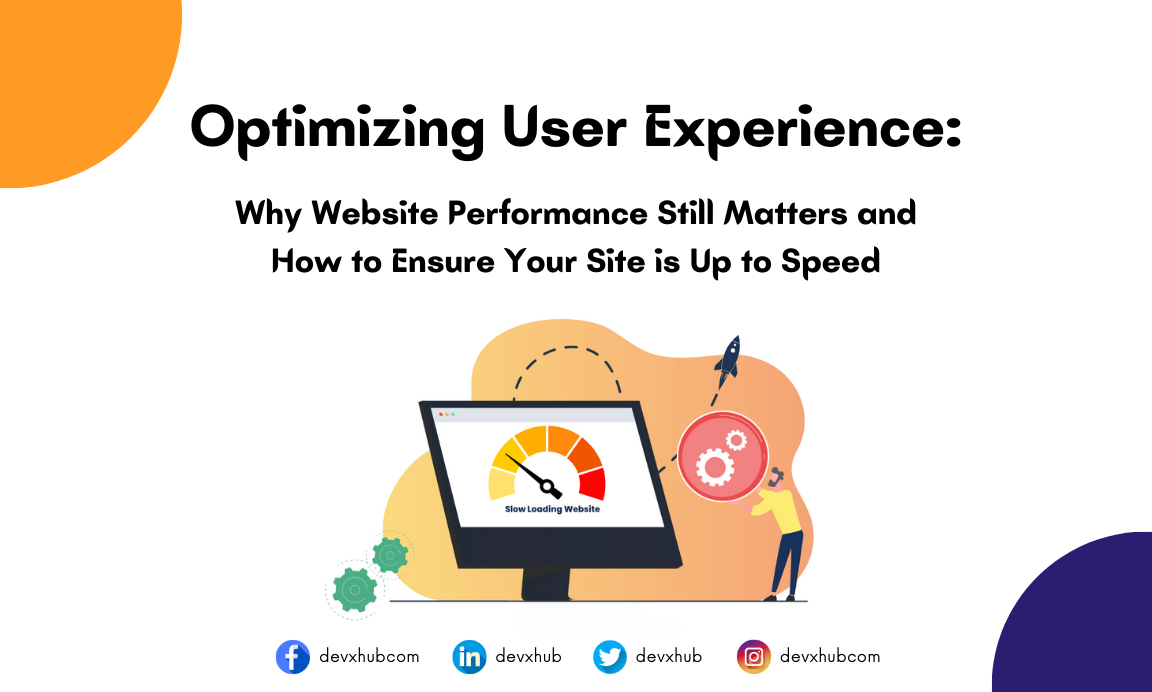Blog - Optimizing User Experience: Website Performance Still Matters & Ensuring Your Site is Up to Speed
In an era where information is at our fingertips and attention spans are fleeting, the speed at which a website operates is a critical factor that can either captivate or repel visitors. The significance of website performance goes beyond mere technicality; it directly influences user experience, search engine rankings, and, consequently, the success of your online endeavors. In this comprehensive exploration, we’ll delve deeper into why website performance is more important than ever and unravel effective strategies to ensure your site is not just functional but also blazingly fast.
1. The Crucial Nexus: User Experience and Website Performance
a. User-Centric Paradigm:
The heart of website performance lies in user experience (UX). Users today demand instantaneous access to content and seamless navigation. A slow website can result in frustrated visitors, leading to increased bounce rates and diminished user satisfaction.
b. The SEO Symphony:
Beyond catering to users, website performance plays a pivotal role in search engine optimization (SEO). Major search engines, including Google, factor in page speed when determining rankings. A faster website not only enhances visibility but also drives organic traffic, making it a cornerstone of your digital marketing strategy.
c. The Conversion Quandary:
In the realm of online business, slow websites are akin to closed doors. Longer load times often translate into lower conversion rates. Whether your goal is sales, sign-ups, or other user actions, a sluggish website can thwart these objectives and undermine your online success.
2. Diagnosing the Need for Speed
a. Toolbox of Insights:
Employing online tools such as Google PageSpeed Insights, GTmetrix, or Pingdom empowers you to dissect your website’s performance. These tools offer a comprehensive analysis, identifying areas for improvement and suggesting optimizations.
b. Deconstructing Sluggishness:
Dive deep into the elements that contribute to slow loading times. Unoptimized images, resource-heavy scripts, or an excess of plugins are common culprits. Identifying and addressing these issues can yield significant improvements.
3. Strategies for Pinnacle Performance
a. The Image Revolution:
Optimize images by compressing and resizing them, striking a balance between quality and file size. Embrace modern image formats and implement lazy loading to ensure that images are loaded only when necessary.
b. Streamline HTTP Requests:
Every element on a webpage necessitates a separate HTTP request. Streamline your website by minimizing the number of elements, combining resources, and employing techniques like asynchronous loading to expedite the rendering process.
c. Harnessing Browser Caching:
Leverage browser caching to store static elements locally on a user’s device. This reduces the need for repeated downloads, enhancing loading times for returning visitors and creating a more efficient browsing experience.
d. Global Reach with CDNs:
Integrate a Content Delivery Network (CDN) to distribute static content across servers worldwide. By reducing latency, CDNs ensure that users experience faster load times, regardless of their geographic location.
e. Crafting the Critical Path:
Prioritize the critical rendering path to ensure that essential elements load swiftly. This strategic approach not only improves actual performance but also enhances perceived speed, allowing users to interact with your site more quickly.
4. The Odyssey of Continuous Improvement
a. Vigilant Monitoring:
Implement performance monitoring tools like New Relic, Datadog, or Google Analytics to keep a watchful eye on your website’s performance metrics. Set up alerts to receive timely notifications of any anomalies that may impact speed.
b. The Symphony of Updates:
Regularly update your content management system, plugins, and other software components. Developers frequently release updates that not only address security concerns but also introduce performance improvements, keeping your website at the forefront of speed and functionality.
Conclusion: Mastering the Symphony of Speed
In the dynamic world of online interactions, where every second counts, optimizing your website’s performance is not merely a technical endeavor; it’s an art form. By prioritizing user experience through swift load times, you not only meet the expectations of your audience but also solidify your position in search engine rankings and increase the likelihood of conversions. Regularly assess and enhance your site’s performance to stay ahead in the digital race, ensuring that your users embark on a seamless and enjoyable journey every time they engage with your online domain. Embrace the art of speed optimization, and watch as your website becomes a beacon of efficiency and excellence in the vast digital landscape.
Related Posts
Categories
- App Development (2)
- Design (2)
- DEVxHUB (30)
- Digital Marketing (2)
- Guide (24)
- It Bangladesh (1)
- Logo design (1)
- Operating system (1)
- Personal Improvement (14)
- Planning (4)
- Project management (3)
- Social media (2)
- Software Development (5)
- Software Quality Assurance (8)
- Startups (1)
- Team work (1)
- UI UX (1)
- Web Development (6)
Main Tags
- 2024
- Android
- app development
- bangladesh
- content writing
- design
- devxhub
- Digital marketing
- Guide
- IOS
- It
- logo design
- Operating system
- Personal Improvement
- planning
- project management
- social media
- Software Development
- Software Quality Assurance
- software testing
- software testing types
- Startups
- Success
- team
- UI UX
- UI UX design
- VR
- Web Development















